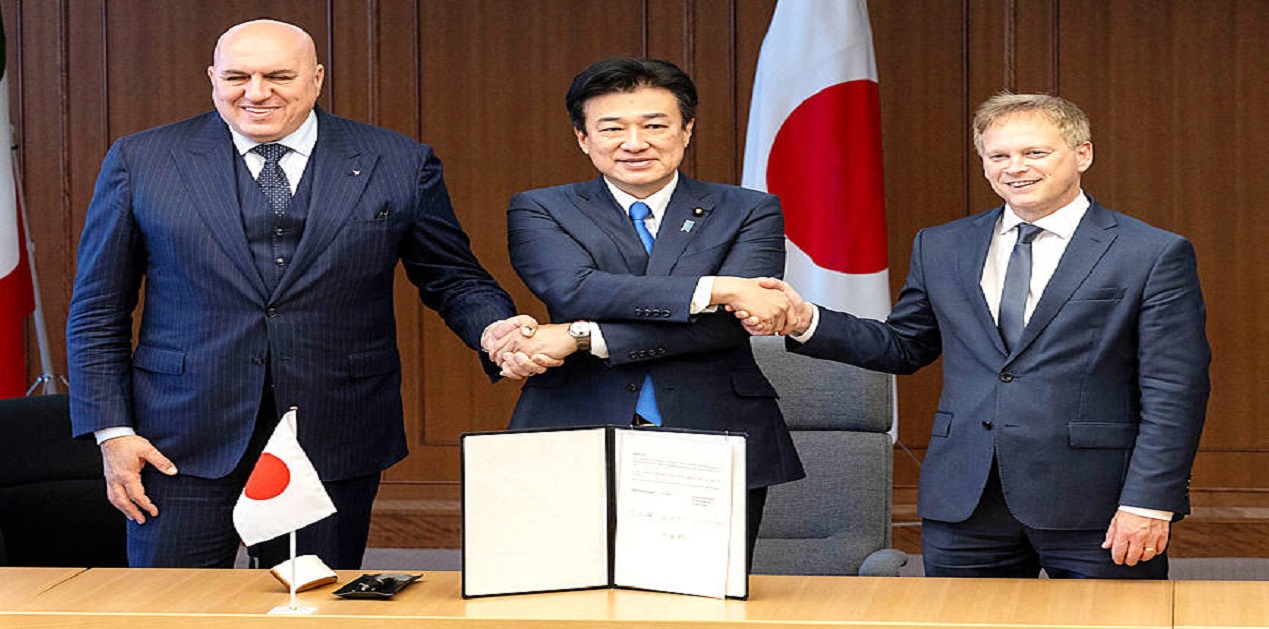In the latest move, Japan on March 26 decided to to ease its strict defence exports’ rules. This has allowed it to build the next-generation fighter jet in collaboration with Britain and Italy to be exported under certain conditions. The defence ministers of Japan, Italy, and the United Kingdom signed an international treaty on the establishment of a joint organization to develop their new sixth-generation fighter jet in December 2023 in Tokyo. It will allow Japan to export lethal weapons it produces to other countries for the first time. This comes with unanimous agreement between the main ruling Liberal Democratic Party and its coalition partner, Komeito Party. This move breaks away from the country's postwar pacifist principles.
In addition, the guidelines for implementing the country's three principles on the transfer of defence equipment abroad were revised. The exports will be limited to the next-generation fighters and can only be transferred to countries that have signed defence deals with Japan and are not involved in active conflicts. The ruling coalition will also hold discussions before the jets are exported. It also notes that each individual export will require Cabinet approval.
The joint co-development between Japan, Italy, and the UK will replace Japan’s aging fleet of American-designed F-2 fighters and the Eurofighter Typhoons used by the UK and Italian militaries. Japan was previously working on a homegrown design to be called the F-X. It merged its effort with a British-Italian programme called the Tempest for deployment in 2035. [1]
Japan-Britain-Italy Axis
In December 2022, in a joint leaders’ statement, the three countries announced their intention to pursue the development of a next-generation fighter by 2035 jointly. This project is called the Global Combat Air Programme (GCAP). It will take more than 10 years to jointly design, develop, manufacture, and deploy the next-generation fighter aircraft.
As per the treaty, the three countries will launch a new organization called the GCAP International Government Organization, or the GIGO, this year. The GIGO aims to centrally manage and operate collaboration between the governments of the three countries and the private sector joint venture, which includes Britain’s BAE Systems PLC, Japan’s Mitsubishi Heavy Industries, and Italy’s Leonardo. This will ensure smooth implementation of the GCAP. The organization will be composed of several hundred government officials from the three countries. It will be headquartered in the United Kingdom, with the first chief executive officer (CEO) coming from Japan.
Under the country's pacifist constitution, Japan has long restricted arms exports. This was due to its wartime past as an aggressor during WW II and the devastation that followed its defeat in the War. Japan adopted a constitution that limits its military to self-defence. The country has, for the longest time, maintained a strict policy to limit transfers of military equipment and technology and ban all exports of lethal weapons. The arms export ban was eased for the first time in 2014 under then-Prime Minister Shinzo Abe. [2] It began to export some non-lethal military supplies, and in December 2023, it approved a change that would allow sales of 80 lethal weapons and components that it manufactures under licenses from other countries back to the licensors. The change cleared the way for Japan to sell US-designed Patriot missiles to the United States, helping replace munitions that Washington is sending to Ukraine.
As a response to drastic changes in the security environment surrounding all three countries, Japan has rapidly taken steps to deregulate. The rising regional and global tensions, especially with China’s rapid strengthening of its military capabilities[3] and increasing assertiveness as threats, and the tensions in the disputed East and South China Seas. Japan also sees increasing joint military exercises between China and Russia around Japan as a threat. This is exemplified by Russia’s invasion of Ukraine and United States’ declining influence, especially in the Global South amid the Israel-Hamas war.
Implications on Security Framework
Japan needs to pump up its defence capabilities to cope up with the changing security environment in the Indo-Pacific region. The project for the development of the new fighter plane is a good start to maintain air superiority, preventing negative impacts on national defence, and enhancing its deterrence capabilities. It will offer better sensing and stealth capabilities, giving it a technological edge against regional rivals China and Russia. It will provide a boost to the Japanese arms industry and bolster its role in global security. In addition, it shows Japan’s readiness to take a greater role in military and defence industry partnerships. The export of warplanes to third countries is necessary to maintain Tokyo's credibility as a partner in other future international defence projects. The potential markets for the jet include the fifteen countries with which Japan has defence partnership agreements, such as the United States, Germany, India, and Vietnam. [4]
The new policy could also help Japan push for a bigger role in alliances and regional defence partnerships like Australia, the US, and the UK’s AUKUS. Strengthening security cooperation between Europe and Japan, that share common values such as freedom, democracy, human rights, and the rule of law, is strategic. [5]
Roadblocks and Challenges Ahead
Japanese public approval is a major issue, as the decision did not provide an explanation to the public or seek approval for the major policy change. However, the government assured that the revised guideline applies only to the jet for the time being and would require Cabinet approval to do so. Potential purchasers will also be limited to the fifteen countries in which Japan has signed defence partnerships and equipment transfer deals.
In addition, the actual performance of the sixth-generation fighter might be a challenge as it envisions the planes to be manned aircraft capable of instructing a large number of unmanned aircraft equipped with AI technology to detect and attack enemy aircraft. Information superiority and high intelligence through sophisticated radar and avionics are essential. A high level of system integration ability is required for this. Furthermore, there may be the possibility of intensifying competition among the three countries for leadership over the division of development roles. [6]
Conclusion
This is the first time that Japan has undertaken co-development of defence equipment on such a large scale with a partner other than the United States. This reorientation in the foreign policy is evident with diversification in partners in the region and beyond. The hard power diplomacy is gaining traction over the soft power diplomacy carried on for ages. This can be a force multiplier and a game-changer in Japanese security architecture. In the multipolar world, strategic alliance and minilateral forum hold significance. Japan's changed security posture is as a response to the unstable geopolitical situation prevailing. However, Japan can demonstrate that it is determined to maintain its postwar status as a peace-loving nation by using a strict process for making decisions and abiding by its pacifist principles. [7]
Endnotes
[1]Mar 26, Apl. U. (2024, March 26). Japan approves plan to sell fighter jets to other nations in latest break from pacifist principles. The Economic Times. https://economictimes.indiatimes.com/news/defence/japan-approves-plan-to-sell-fighter-jets-to-other-nations-in-latest-break-from-pacifist-principles/articleshow/108777938.cms
[2]Japan to sell fighter jets in latest break from post-war pacifist ideals. (2024, March 26). https://www.bbc.com/news/world-asia-68662465
[3]Mar 26, Apl. U. (2024, March 26). Japan approves plan to sell fighter jets to other nations in latest break from pacifist principles. The Economic Times. https://economictimes.indiatimes.com/news/defence/japan-approves-plan-to-sell-fighter-jets-to-other-nations-in-latest-break-from-pacifist-principles/articleshow/108777938.cms
[4]Will Japan export lethal arms soon? Why is this decision controversial? (2024, March 26). Firstpost. https://www.firstpost.com/explainers/japan-export-lethal-arms-changes-controversial-13752714.html
[5] Japan will allow fighter jets being developed with UK, Italy to be exported | NHK WORLD-JAPAN News. (n.d.). NHK WORLD. Retrieved March 27, 2024, from https://www3.nhk.or.jp/nhkworld/en/news/20240326_10/
[6]Japan-Italy-UK Joint Fighter Program Takes a Step Forward With New Treaty. (n.d.). Retrieved March 27, 2024, from https://thediplomat.com/2023/12/japan-italy-uk-joint-fighter-program-takes-a-step-forward-with-new-treaty/
[7]Japan will allow fighter jets being developed with UK, Italy to be exported | NHK WORLD-JAPAN News. (n.d.) . NHK WORLD. Retrieved March 27, 2024, from https://www3.nhk.or.jp/nhkworld/en/news/20240326_10/
(The paper is the author’s individual scholastic articulation. The author certifies that the article/paper is original in content, unpublished and it has not been submitted for publication/web upload elsewhere, and that the facts and figures quoted are duly referenced, as needed, and are believed to be correct). (The paper does not necessarily represent the organisational stance... More >>
Image Source: https://www.taipeitimes.com/images/2024/03/27/P05-240327-303.jpg











Post new comment